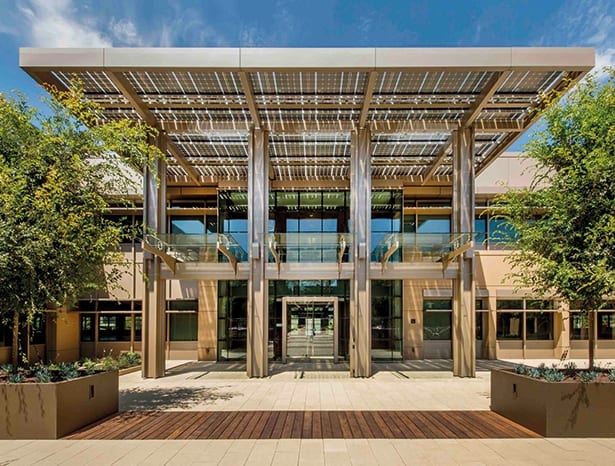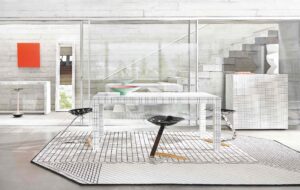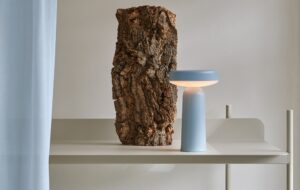 An overhang cools Hanover Page Mill’s entrance façade|||
An overhang cools Hanover Page Mill’s entrance façade|||
Along with the growth of workplaces that take sustainability seriously, in offices everywhere nature is increasingly making its presence felt. Plant-studded living walls might have once seemed a fleeting fad, but they’ve put down roots as a perennially covetable feature. Nature is also invading the offices of bluechip companies in the form of spectacular jungle-like internal gardens and courtyards or roof terraces, which offer employees luxuriantly planted outdoor rooms that dissolve the traditional boundary between indoors and out.
On the architecture front, many new offices, such as Hanover Page Mill in Palo Alto, California – designed by San Francisco-based practice Form4 Architecture for speculative developers James Gaither Sr and his son, James Gaither Jr, a former ecologist – are radically self-sufficient in their use of electricity and water. The building, which won a Leading European Architecture Forum (LEAF) award in the Best Sustainable Development category last year, features a courtyard with plants that are resistant to droughts and so require less irrigation.
 Drought-resistant plants were chosen for the courtyard at Hanover Page Mill
Drought-resistant plants were chosen for the courtyard at Hanover Page Mill
It’s not surprising that greenery in workplaces is welcomed: it provides a visually soothing, potentially ever-changing backdrop and softens the hard lines of architecture. One reason for the rise in the number of sustainable offices is that companies are not just concerned about the environment but acting out of enlightened self-interest. As well as incorporating greenery, they are addressing other issues that can affect their staff’s wellbeing, including noise levels and temperatures that are comfortable to work in. Biophilia — the notion that humans like to gravitate towards nature — is also gaining greater credence.
A report published last year by The World Green Building Council called Building the Business Case: Health, Wellbeing and Productivity in Green Offices has identified 15 buildings around the world that have invested in making their offices greener in a highly sophisticated way and subsequently seen improved productivity. The report claims this can be quantified. It cites, for example, the redesigned Doncaster office of Swedish construction and development company Skanska, which now has more daylight thanks to a new lightwell, more natural ventilation and lower noise levels. The report states that 3.5 fewer building-related sick days have been taken per employee each year there compared with their other UK offices, saving the company £28,000 in 2015.

The Diorama at Angel Court creates its own ecosystem
A particularly striking example of nature permeating contemporary architecture can be found at Angel Court in the City of London, occupied by BUPA’s global HQ, the office of Shanghai Pudong Development Bank as well as restaurants. Behind its reception is an open-air, glass-fronted 30m-long slice of tropical forest called the Diorama, created by landscape architect Martijn Slob of the company Vogt Landscape. The thinking behind it was to fuse the contemporary and primeval – to imagine how this part of London might have looked long before the city was built, juxtaposed with a modern interior. The garden is truly organic since it will create its own ecosystem as insects and birds begin to colonise it.
A 25-storey 1970s building close to Bank station, Angel Court has been redesigned by Fletcher Priest Architects, which also created vegetable gardens with beehives on the roof of law firm Eversheds in 2008. On its seventh floor is a 1,580sq m outdoor terrace that is accessible to all occupants. With generously sized lawns, tall hedges, trees and benches, it resembles a park or garden square.
 Slob’s landscape aims to bring the forest into the office
Slob’s landscape aims to bring the forest into the office
“The terrace is laid out like garden rooms and the hedges frame outstanding views of London’s skyline and provide really effective windbreaks,” says Ed Williams, partner at Fletcher Priest. Fronting the tower are floor-to-ceiling windows affording more vistas of the garden.
Meanwhile, in the courtyard of Silicon Valley-based Hanover Page Mill – occupied by law firm Morgan, Lewis & Bockius and financial services company Morgan Stanley – are indigenous plants, among them strawberry trees and bush anemones, which are irrigated using recycled water from a local municipal supply. Overhangs projecting from the facade keep its interior cool. And solar panels on its roof and on carports provide the building with all the electricity it needs, including the 16 electric car-chargers that encourage use of lower-emission electric vehicles. It also uses 40% less water than a comparable building for flushing toilets, handwashing and showering, thanks to taps that restrict flow.
 Seventh floor gardens at Angel Court are shared
Seventh floor gardens at Angel Court are shared
Back in the UK, Surrey-based Scotscape is busy greening the interiors of offices with its sought-after living walls, for example those of film production company Moving Picture and multinational property developer Lendlease, both in London. Angus Cunningham, the company’s Scottish-born MD, explains their appeal: “Living walls are increasingly popular in offices as awareness of the benefits of plants for health and wellbeing grows. After all, they improve air quality via the plants’ ability to remove VOCs [volatile organic compounds], some of which are harmful, connect staff to nature, which reduces stress and improves wellbeing, regulate air temperature and humidity and provide acoustic benefits by deadening noise.”
In short, companies and architects are acknowledging the advantages of greening offices in a very rounded way, factoring in not simply the agreeable atmosphere plants inevitably create but also such considerations as a desire to control temperature and noise levels and maximise daylight and natural ventilation.
 A living wall by Scotscape in Moving Picture’s offices
A living wall by Scotscape in Moving Picture’s offices
This article first appeared in the July issue of OnOffice
Brands and designers are finally recognizing the benefits of greening offices




















